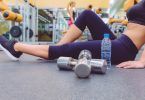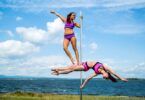Flexibility is a cornerstone of pole yoga, enabling dancers and fitness enthusiasts to help them realize their full potential. As a fusion of yoga and pole fitness, pole yoga focuses on enhancing strength, improving balance, and increasing flexibility. Whether you’re perfecting aerial tricks or executing graceful pole spins, pole yoga offers an engaging way to reach new heights in your fitness journey.
What Is Pole Yoga?
Pole yoga is an innovative fusion of traditional yoga and pole fitness that combines flexibility, balance, and strength-building exercises with the artistic and physical challenges of pole dancing. This practice utilizes yoga-inspired poses, stretches, and mindfulness techniques while incorporating the pole as a prop for support, resistance, and elevation. Whether you’re a beginner or a seasoned pole dancer, pole yoga offers a versatile and engaging workout that promotes both physical and mental well-being.
By blending the mindful movements of yoga with the dynamic energy of pole fitness, pole yoga helps practitioners build lean muscles, improve posture, and enhance flexibility while fostering confidence and creativity.
Why Flexibility Matters in Pole Yoga
Flexibility is a great ingredient for keeping your muscles lean and strong as you age. Stretching is thus important if you want to be less prone to injuries whenever you use different muscles in your body. Pole and Aerial Fitness involves a lot of bending, which you can only achieve if you are flexible.
The approach that you take and what you say to yourself matters a lot. Increasing your flexibility is not only good for your pole dancing but also comes with loads of health benefits that you will experience even after your sessions. Pole dancing comes in handy if you are looking for an activity that will help you shed that extra weight. Your metabolic levels rise as you become more active, which means that you burn more fat. Your cardiovascular health benefits a lot, and exercise opens up your lungs, which improves blood and air circulation.
Your mental health also receives a boost when you engage in exercise. Your brain releases endorphins, the happiness hormone when you become active. It thus is an awesome approach to reducing stress and anxiety. It is also a great chance to interact with other people when you train as a team.
Effective Ways to Increasing Your Flexibility at the Pole
Attend a flexibility class
Many experts out there can help you get better at the craft depending on your end goals. There are both free and paid classes. It is thus important to research to determine what suits you best. Do you want to do pole and aerial dancing for fun, or do you want to take it as a career? If you want the latter, then you must invest in it and ensure that you only train with the best.
Depending on your schedules and ease of accessibility, you can either decide to attend a virtual or physical class. You can also combine the two approaches to ensure that you get the best out of the two worlds. Working under a teacher makes it easy to master different steps and speed up the learning process. You will also learn when it is too much and how to avoid injuries.
Essential Tools for Your Pole Yoga Practice
What do you do when you want to get lean muscles or even add muscle mass? You are most likely to lift weights or even invest in a pair of dumbbells that you can use at home. Making your legs more flexible also requires a similar approach. There are tools for stretching your legs to help you achieve the flexibility you are craving irrespective of whether you want to become a professional dancer or want to do it for fun.
The ideal tools also build strength as you need while you are up there on the pole. These tools come in different shapes, and some are compatible, which makes them easy to store. Evaluate your physical fitness and needs before you invest in such tools.
How to Set Goals and Stay Consistent with Pole Yoga
It is okay to feel anxious before attending the first pole class. Learning is a process, and you must be committed if you want to achieve your goals. You need to warm up your muscles and train them through continued efforts. Starting flexibility exercises and then quitting after one week will not help your body in any way.
You can start small and then improve as you get used to the exercises. For instance, you can start with just 15-minute stretches daily for the first week and then increase them to 25 minutes. Set up a schedule that you can follow based on your hands and daily commitments. It does not matter if you train early in the morning or the evening. What matters is if you are consistent. You can always have makeup sessions whenever you miss one. Set some goals that you can easily follow up to ensure that you are on the right path.
Know your limits
You may want to become a champion in the shortest time possible. It is okay to be overambitious. Most people say that there is no gain without pain. It is true to some extent, but you also need to listen to your body. Your muscles need enough time to relax, or else you end up with injuries, or you wear out. You need to know when to stop and when to push harder.
Getting someone who can analyze your progress can help a great deal towards getting that flexible body. The ideal trainer will guide based on your physical abilities and what you want to achieve. Have someone that you can always talk to when you feel as if something is not right. Do not let your injuries worsen as you may end up with some permanent ones.
Be yourself
Do you have a role model in this field? It is okay to have someone who inspires you. However, it would be best to realize that being you will help unleash the beast in you. You may feel as if other people are doing better than you. But comparing yourself with others is self-destruction. You need to understand that people have different capabilities.
Always aim at becoming a better version of yourself and improve every day. It is okay to have some partners that will motivate you to become better. Be ready to receive positive criticism and know the areas that you need to improve on. Set realistic goals and come up with checks to determine your progress.
Common Mistakes to Avoid in Pole Yoga
- Skipping Warm-Ups or Cool-Downs
Many practitioners dive straight into their routines without properly warming up their muscles, increasing the risk of injury. Similarly, skipping a cool-down prevents muscles from recovering effectively and can lead to stiffness or soreness. - Overstretching or Forcing Poses
Flexibility takes time to develop. Overstretching or forcing your body into advanced poses before you’re ready can result in muscle strains or injuries. Always progress gradually and listen to your body. - Relying Too Much on Upper Body Strength
While pole yoga builds upper body strength, neglecting core engagement and lower body coordination can limit your progress. Focus on using your entire body for balance and movement. - Using Improper Grip Aids
Overusing grip aids or relying on the wrong products can affect your technique and compromise safety. Make sure you’re using grip aids sparingly and choosing ones suited for your skin type and environment. - Neglecting Proper Pole Maintenance
A dirty or improperly secured pole can lead to slips and falls. Always clean your pole and ensure it’s securely installed before beginning your practice. - Ignoring Body Alignment
Poor posture and misalignment during poses can lead to injuries or imbalances over time. Pay attention to your instructor’s cues or use a mirror to ensure correct alignment throughout your routine. - Skipping Strength Training
Flexibility and strength go hand in hand. Neglecting strength-building exercises, such as planks or push-ups, can make it harder to execute poses safely and effectively.
By avoiding these common mistakes and focusing on proper technique, you can maximize the benefits of pole yoga while reducing the risk of injury. Remember, progress is a journey—embrace the process and enjoy each step along the way!
Conclusion
Embracing flexibility is a fundamental aspect of excelling in aerial and pole dancing. By consistently working on your flexibility, attending classes, utilizing the right tools, and setting realistic goals, you can unlock new heights in your dance journey. Remember, progress takes time, so listen to your body, stay dedicated, and celebrate every milestone achieved. With perseverance and a commitment to self-improvement, you can transform into the best version of yourself as an aerial and pole dancer.
FAQs about Pole Yoga
- What is pole yoga?
Pole yoga combines the principles of yoga with pole fitness to enhance strength, flexibility, and balance. - Is pole yoga suitable for beginners?
Yes! Pole yoga caters to all levels, offering modifications to build flexibility and confidence over time. - What are the benefits of pole yoga over traditional yoga?
Pole yoga adds a dynamic element to traditional yoga by incorporating aerial and strength components, making it a full-body workout. - Can I practice pole yoga at home?
Yes, with the right equipment and proper instruction, pole yoga can be safely practiced at home. Just ensure your pole is securely installed, and consider investing in a crash mat for added safety. - How long does it take to see progress in flexibility?
Progress varies by individual, but with consistent practice, most people notice improvements in flexibility within a few weeks.






